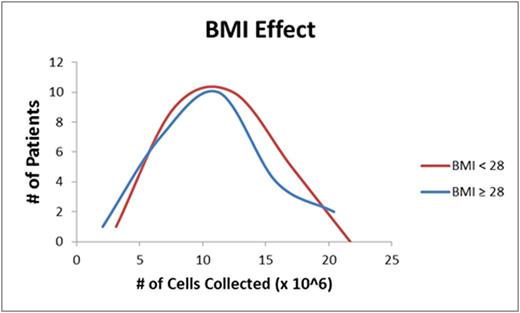Abstract
Background
Plerixafor and granulocyte-colony stimulating factor (G-CSF) are commonly used in combination to mobilize CD34+ cells for collection for autologous hematopoietic stem cell transplantation (HSCT). Standard protocol involves four consecutive days of G-CSF followed by plerixafor, administered 11 hours before apheresis (for 8 am harvest next day, 9 pm administration the night before harvest). However, this timing is often logistically impractical for both patients and staff members. To examine whether plerixafor could be given on a less stringent timeline without compromising efficacy, we conducted a retrospective review of multiple myeloma patients who underwent mobilization and collection at our institution from 2010 to 2013. A further subset analysis was also performed on patients based on patient comorbidities such as age, BMI, and prior treatment with Lenalidomide to assess whether or not the earlier administration of plerixafor would affect cell collections in patients with differing characteristics.
Methods
52 consecutive patients with multiple myeloma at the University of Arizona Cancer Center were studied to analyze the effectiveness of G-CSF/Plerixafor mobilization with plerixafor given at approximately 14 to 17 hours before apheresis instead of 11 hours as instructed by plerixafor package insert. G-CSF was given according to standard protocol, with patients receiving a rounded dose of 10mcg/kg, to either 300 or 480mcg daily, at 0800 for four consecutive days. Plerixafor was given on the 4th day at 14 to 17 hours (2-5 PM instead of 9PM) before apheresis, which commenced at 0800 the following morning. Patients were given additional doses of plerixafor if inadequate numbers of cells were collected in the initial apheresis session.
Results
The patient population consisted of 52 consecutive patients, aged 36 to 77 years old, with BMIs ranged 18.7 to 46.6, of which 28 had previously been treated with Lenalidomide. The median number of apheresis sessions to reach goal CD34+ count of 2 X 10^6 was 1 (range 1-4). 11 patients required 2 or more collections (6 patients required 2 collections, 4 required 3, and one individual required 4 collections). Mean CD34+ count collected after all required apheresis sessions per patient was 9.74 x 10^6 (range 2.07 x 10^6 - 24.99 x 10^6). All patients collected sufficient stem cells to proceed with autologous HSCT. Patient were then divided into further groups for further analysis: age (62 or less vs greater than 62), BMI (less than 28 vs 28 or greater), and lenalidomide treatment in the past. None of those three characteristics showed any statistical difference in the number of CD34+ stem cells collected (See graph 1, 2, and 3).
Conclusion
Based on these data, plerixafor mobilization remains an effective method of stem cell mobilization despite lengthening of the interval from medication administration to apheresis. Moreover, this alleviates the major logistical disadvantage of using plerixafor for stem cell mobilization.
McBride:Sanofi: Research Funding.
Author notes
Asterisk with author names denotes non-ASH members.




This feature is available to Subscribers Only
Sign In or Create an Account Close Modal